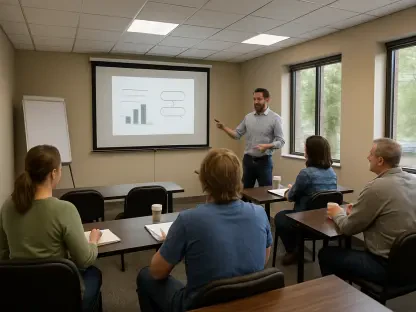Hidden within the daily rhythm of the University of Pittsburgh lies an indispensable force that ensures the campus thrives, often without fanfare or recognition. The Office of Facilities Management, overseeing a sprawling network of buildings and systems, stands at a pivotal moment of leadership transition between outgoing Vice Chancellor Scott Bernotas and incoming Vice Chancellor Laura Zullo. With a workforce exceeding 600 dedicated individuals, this department handles an array of critical tasks—from clearing snow in the harshest winter hours to maintaining century-old structures. Their efforts, though vital to the university’s operations, frequently go unnoticed until something falters. This narrative of silent perseverance and the leaders’ deep appreciation for their team’s grit sets the stage for a closer look at the challenges, triumphs, and future direction of facilities management at Pitt, revealing the backbone of a campus that supports thousands daily.
Leadership Transition and Vision
Reflecting on a Decade of Growth
The transition within Pitt’s Office of Facilities Management marks the end of an era for Scott Bernotas, who retires after ten years of transformative leadership, and the beginning of a new chapter under Laura Zullo, a seasoned professional with nearly three decades of experience at the university. Bernotas’s tenure saw remarkable strides in expanding the department’s scope and capabilities, yet both leaders share a profound respect for the staff whose tireless work keeps the campus running seamlessly. Their shared sentiment is clear: the facilities team’s efforts are often invisible, only drawing attention when disruptions occur. Whether it’s ensuring heat during frigid winters or maintaining pristine grounds, the dedication of these workers forms the foundation of Pitt’s daily life. This mutual admiration underscores a leadership philosophy rooted in recognizing the value of every contribution, no matter how unseen.
Beyond the acknowledgment of hard work, Bernotas and Zullo reflect on the personal and professional dimensions of their roles during this handover. Bernotas, stepping away to prioritize family time, leaves behind a legacy of resilience and progress, having guided the department through significant growth and modernization. Zullo, returning to facilities management after broader administrative roles at Pitt, brings a blend of nostalgia and strategic insight to her new position. Her deep-rooted connection to the department, paired with an eagerness to reconnect with the team, signals a commitment to continuity while embracing change. Their perspectives converge on a central truth: the facilities staff’s unwavering commitment, often under grueling conditions like early-morning snow removal, deserves far greater recognition than it typically receives. This transition, therefore, is not just about leadership but about amplifying the story of those who sustain Pitt’s infrastructure.
Looking Ahead with Experience
The vast responsibilities of Pitt’s Facilities Management team paint a picture of a department that never rests, as Bernotas aptly describes the work as continuing “every day, every day, every day.” The scope of their duties spans from routine cleaning and building repairs to operating complex utility plants that regulate campus heating and cooling. A robust support system of engineers, accountants, and procurement specialists ensures these operations run smoothly behind the scenes. This relentless pace highlights the critical nature of their role in maintaining a functional environment for students, faculty, and staff. As Zullo steps into her leadership position, she faces the challenge of upholding these standards while navigating the intricacies of a department that touches every corner of campus life. Her focus on understanding the team’s current dynamics suggests a thoughtful approach to sustaining this essential work.
As Pitt’s campus has evolved, so too has the complexity of its facilities, presenting both challenges and opportunities for innovation. Under Bernotas’s watch, the number of managed buildings nearly doubled from 80 to 140, incorporating housing and dining facilities into the department’s portfolio. This expansion necessitated the adoption of standardized processes and advanced tools to streamline operations amid growing demands. Zullo, eager to immerse herself in these developments, expresses a keen interest in learning about recent advancements and operational shifts. Her engineering background and long history with Pitt equip her to tackle the sophisticated building control systems that define modern campus infrastructure. This forward-looking mindset, combined with a respect for past achievements, positions her to guide the department through an era of increasing technical and logistical challenges while maintaining the high standards set by her predecessor.
Challenges and Achievements in Facilities Management
Balancing Preservation and Constraints
Preserving the rich history embedded in Pitt’s campus infrastructure remains a cornerstone of the Facilities Management mission, yet it comes with significant hurdles that both leaders acknowledge. With 27 buildings over 100 years old, the department must prioritize ongoing investment to safeguard these structures, a commitment Bernotas credits to the university’s senior leadership and Board of Trustees. These historic assets, while emblematic of Pitt’s legacy, demand meticulous care and substantial resources to remain functional and safe. The workload tied to preservation has grown, reflecting a broader dedication to extending the lifespan of campus landmarks. However, maintaining such standards across an expanding portfolio tests the department’s capacity, requiring a delicate balance between honoring the past and meeting present-day needs in a resource-constrained environment.
Fiscal challenges loom large as a barrier to sustaining Pitt’s high standards of facilities care, an issue Zullo identifies as a key concern moving forward. With campus growth placing additional strain on budgets, finding creative solutions becomes imperative to ensure that service quality does not suffer. The need to allocate funds efficiently while addressing the complex demands of both new and historic buildings underscores the strategic planning required in her new role. Bernotas’s era saw significant strides in preservation, but Zullo must now navigate these financial constraints without compromising the department’s mission. Her intent to explore innovative approaches across operations and finance hints at a proactive stance, aiming to uphold the integrity of Pitt’s infrastructure despite economic pressures. This focus on adaptability will be crucial as the campus continues to evolve and expand its physical footprint.
Investing in Progress
Strategic investments in Pitt’s infrastructure have yielded measurable improvements, a point of pride for Bernotas as he reflects on his decade of leadership. Initiatives such as establishing a 24/7 energy management operation center and constructing a new chilled water plant have enhanced campus conditions, with external assessments in recent years confirming consistent progress. These projects not only bolster operational efficiency but also contribute to long-term sustainability goals. However, Bernotas cautions that halting such investments could rapidly reverse these gains, emphasizing the fragility of progress without sustained funding. This warning serves as a reminder of the delicate balance between current achievements and future risks, highlighting the importance of continued university support to maintain the momentum built over years of dedicated effort.
Modernization has been a game-changer for Pitt’s Facilities Management, transforming how the department operates in response to growing demands. Bernotas spearheaded the implementation of a computerized maintenance management system to handle over 92,000 annual work orders, moving away from outdated manual methods to a more efficient digital framework. Innovations like the chilled water plant, which also captures stormwater to reduce utility costs, exemplify a commitment to sustainability and redundancy in campus planning. Zullo’s determination to familiarize herself with these updates indicates a desire to build on this foundation of progress. Her approach suggests a blend of respect for established systems and a drive to integrate new technologies or strategies that could further optimize operations, ensuring that Pitt remains at the forefront of facilities management practices.
The Heart of Pitt’s Infrastructure
Celebrating the Unsung Heroes
At the core of Pitt’s Facilities Management lies a workforce that both Bernotas and Zullo regard as the department’s greatest strength, often describing them as the unsung heroes of campus life. Bernotas praises the team as a “great crew” with a genuine commitment to the university’s well-being, a sentiment echoed by Zullo, whose return to the department feels like a homecoming after years in broader administrative roles. Their collective appreciation shines a light on staff who labor under challenging conditions—whether clearing snow at 4 a.m. or repairing critical systems during off-hours—to keep Pitt operational. This recognition from leadership underscores a culture of gratitude, aiming to elevate the visibility of a team whose contributions are foundational yet frequently overlooked by the wider campus community.
The human element of facilities management emerges as a unifying theme in the leaders’ reflections, emphasizing the personal dedication behind every task. Zullo’s deep history with Pitt, including early projects like steam line replacements, grounds her in the operational realities faced by staff, while Bernotas’s decade-long journey reflects a profound connection to the team’s resilience. Their shared focus on fostering a supportive environment suggests that staff morale and well-being are as critical as infrastructure itself. As challenges like fiscal constraints and campus growth persist, both leaders advocate for sustained university investment not just in buildings, but in the people who maintain them. This perspective frames the department as a vital pillar of Pitt’s success, reliant on the grit and loyalty of its workforce to navigate future obstacles with unwavering determination.
Building a Sustainable Future
Looking back, the journey of Pitt’s Facilities Management under Bernotas’s guidance revealed a department that adapted to immense growth and embraced innovation, from expanding its building portfolio to integrating cutting-edge systems. Zullo’s arrival marked a moment of reflection on past achievements, with her extensive experience at the university providing a strong foundation to address upcoming challenges. Their mutual respect for the staff’s dedication resonated throughout their tenures, as did their insistence on the importance of continued funding to prevent setbacks in campus conditions. These shared values shaped a narrative of quiet perseverance, where the team’s hard work remained the heartbeat of every success, even if rarely acknowledged by those who benefited daily.
As the department moved forward, actionable steps emerged as critical to sustaining progress. Prioritizing creative financial strategies to counter budget constraints stood out as a key focus, alongside further investment in technologies that enhance efficiency and sustainability. Zullo’s intent to deepen her understanding of recent operational changes hinted at a roadmap for integrating new solutions while preserving the department’s core mission. Additionally, fostering greater campus-wide awareness of the facilities team’s role could bridge the recognition gap, ensuring their efforts received the appreciation they deserved. These considerations, rooted in a blend of innovation and advocacy, positioned Pitt’s Facilities Management to build on its legacy, safeguarding the campus environment for generations to come.








